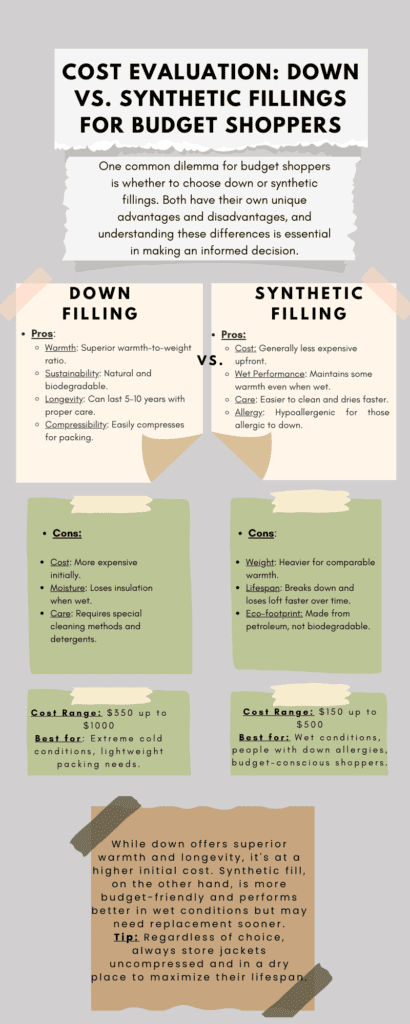Cost Evaluation: Down vs. Synthetic Fillings for Budget Shoppers

In today’s market, there are numerous options available for insulation. One common dilemma for budget shoppers is whether to choose down or synthetic fillings. Both have their own unique advantages and disadvantages and understanding these differences is essential in making an informed decision. Let’s delve deeper into the world of insulation and explore the cost implications of down and synthetic fillings.
Key Takeaway
When evaluating the cost of down versus synthetic fillings, especially for budget-conscious shoppers, several key points should be considered:
- Initial Cost: Synthetic fillings are generally less expensive upfront compared to down. This makes them a more budget-friendly option for those who are cost-conscious or for occasional outdoor enthusiasts.
- Longevity and Durability: While down is initially more expensive, it tends to have a longer lifespan than synthetic fillings. Down maintains its loft and insulating properties over many years if properly cared for, potentially offering better long-term value.
- Performance Over Time: Synthetic insulation typically degrades faster in terms of loft and warmth. This means that over time, you might need to replace synthetic-insulated gear more frequently than down, which could offset the initial cost savings.
- Care and Maintenance: Down requires careful washing and drying to maintain its loft and effectiveness, which can be more time-consuming or require professional services. Synthetic fillings are usually easier to care for, often machine washable and dryable, making them less costly and less labor-intensive to maintain.
- Comfort and Packability: Down is known for its superior warmth-to-weight ratio and compressibility, making it ideal for activities where weight and space are concerns. Synthetics are improving in this area but generally still lag behind.

Understanding Down and Synthetic Fillings
Before we analyze the costs, it is important to understand exactly what down and synthetic fillings are.
When it comes to insulation, the choice of filling can greatly impact the comfort when out during the winter season. Down and synthetic fillings are two popular options that offer different benefits and characteristics.
What is Down Filling?
Down filling is made from the soft plumage found beneath the feathers of ducks and geese. These fluffy clusters provide exceptional warmth and insulation, making down a popular choice for insulation in jackets, sleeping bags, etc.
But what makes down filling so special? Well, Down is known for its incredible ability to trap air and create a layer of insulation. This means that it can keep sleepers warm in the colder months, while also allowing for breathability and preventing overheating in the warmer months.
In addition to its temperature-regulating properties, Down is also renowned for its lightweight and fluffy texture. When you slip into a down-filled sleeping bag or jacket, you’ll experience a luxurious and cloud-like feel that is hard to replicate with other materials.
What is Synthetic Filling?
Synthetic filling, on the other hand, is man-made and typically consists of polyester fibers. These fibers are designed to mimic the properties of down, offering similar warmth and comfort. Synthetic fillings are often hypoallergenic and a more affordable alternative to down.
While synthetic fillings may not have the same natural origins as down, they have their own set of advantages. One of the key benefits of synthetic fillings is their hypoallergenic nature. For individuals with allergies or sensitivities, synthetic fillings are the best option.
Another advantage of synthetic fillings is their ease of maintenance. Unlike down, which requires special care and professional cleaning, synthetic fillings can be easily machine-washed and dried. This makes them a practical choice for those who prefer low-maintenance options.
Synthetic fillings tend to retain their shape even after repeated use and washing. This means that your jackets and sleeping bags will stay plump and fluffy, providing consistent support and comfort throughout their lifespan.
Whether you choose down or synthetic filling, both options have their own unique qualities that can enhance your experience. It ultimately comes down to personal preference, budget, and any specific needs or considerations you may have.

The Cost of Down Fillings
When considering the cost of down fillings, it is important to take various factors into account.
Down fillings, known for their luxurious comfort and exceptional insulation properties, come in a range of prices. Understanding the factors that influence the cost can help you make an informed decision when purchasing.
Factors Influencing the Price of Down
One crucial factor is the quality of the down. Higher quality down, often referred to as “pure down” or “white down,” is more expensive due to its superior insulating properties. This premium down is carefully selected and processed to ensure maximum loft and warmth. On the other hand, lower quality tends to be more affordable, but it may not provide the same level of warmth and durability.
The fill power, which measures the fluffiness of the down, also affects the price. The higher the fill power, the more expensive the jacket is. Fill power is an indicator of the down’s ability to trap air and provide insulation. Higher fill power down has larger and stronger clusters, resulting in better insulation and a lighter feel.
Additionally, the source of the down can impact the cost. Down from mature geese is generally more expensive compared to down from younger birds. Mature geese produce larger and more mature down clusters, which contribute to better insulation and overall quality. However, it is important to note that down from younger birds can still provide excellent comfort and warmth at a more affordable price point.
Lastly, the brand and retailer can also influence the pricing. Well-known brands and high-end retailers often charge a premium for their down jackets. This can be attributed to their reputation for quality, craftsmanship, and attention to detail. While purchasing from a reputable brand can provide peace of mind, it is worth exploring other options as well, as there are many lesser-known brands that offer high-quality down at more affordable prices.
Long-term Value of Down Fillings
Despite the higher upfront cost, down fillings can provide long-term value for budget shoppers. Due to their exceptional insulation properties and durability, down jackets and sleeping bags can last for many years if properly cared for. With regular fluffing and occasional professional cleaning, down jackets can maintain their loft and performance for an extended period of time.
The natural breathability of the down allows you to stay comfortable throughout the year, eliminating the need to purchase separate jackets for different seasons. Down fillings have the unique ability to regulate body temperature by wicking away moisture and allowing air circulation, ensuring a cozy environment regardless of the weather.
When considering the cost of down fillings, it is important to weigh the initial investment against the long-term benefits and value. By choosing high-quality down, understanding fill power, considering the source, and exploring different brands, you can find the perfect down jackets that meet your budget and provide the ultimate outdoor experience.
The Cost of Synthetic Fillings
Synthetic fillings have gained popularity in recent years due to their affordability and practicality. However, there are several factors that influence the price of synthetic fillings, making it important to consider all aspects before making a purchase.
Factors Influencing the Price of Synthetic
Similar to down fillings, the quality of synthetic fillings plays a role in determining the price. Higher-quality synthetic fillings, often labeled as “premium” or “microfiber,” are generally priced higher due to their superior comfort and durability.
But it’s not just the quality that affects the cost. The thickness or weight of the synthetic filling can also impact the price. Thicker fillings provide greater warmth but come at a higher price. This is because more material is used to create a denser filling, resulting in increased production costs.
In addition to quality and thickness, the brand and retailer can also impact the pricing. As with down fillings, well-known brands, and higher-end retailers tend to charge more for their synthetic bedding. This is often due to the reputation and trust associated with these brands, as well as the additional costs of marketing and distribution.
Long-term Value of Synthetic Fillings
While synthetic fillings may not offer the same long-term value as down fillings, they present their own advantages for budget-conscious shoppers. Synthetic is often more affordable upfront, making it a suitable option for those looking to save money.
Synthetic fillings are typically easier to clean and are often machine-washable, reducing the need for professional laundering or dry cleaning. This convenience can result in long-term cost savings since cleaning expenses are minimized. Additionally, synthetic fillings are hypoallergenic, making them a great choice for individuals with allergies or sensitivities.
It’s important to note that while synthetic fillings may be more affordable, they may not have the same level of breathability as down fillings. This can lead to a less comfortable experience for some individuals, especially in warmer climates or for those who tend to feel hot.
It’s essential to consider your specific needs and budget when choosing between synthetic and other types of fillings to ensure you make an informed decision.
Comparing Down and Synthetic Fillings
Now that we have explored the costs of down and synthetic fillings individually, let’s compare the two options side by side.

Initial Purchase Price Comparison
When comparing the initial purchase price, synthetic fillings generally have a lower price point compared to down fillings. This affordability makes synthetic a popular choice among budget shoppers.
But it’s important to consider the long-term value of your investment. While down fillings may have a higher upfront cost, their superior durability often outweighs the initial price difference. High-quality down jackets can last for years without losing their loft or warmth, resulting in potential long-term savings.
On the other hand, synthetic fillings may require more frequent replacements as they tend to lose their loft over time. This can be a consideration for those looking for a long-term solution.
Also, the lower upfront cost of synthetic jackets can offset the need for more frequent purchases. For those who prefer to experiment with different styles, synthetic fillings may be a more cost-effective option.
Durability and Maintenance Costs
When it comes to maintenance costs, down fillings may require professional laundering or dry cleaning, which can add additional expenses. This is especially important to consider for individuals with allergies or sensitivities, as proper cleaning is crucial to maintain the hypoallergenic properties of down.
On the other hand, synthetic fillings are often machine-washable, reducing the need for professional cleaning and lowering long-term maintenance costs. This convenience can be a significant advantage for those who prefer an easy-to-care-for option.
It’s worth noting that while down fillings may require more specialized care, they can also be rejuvenated through a process called “fluffing.” By periodically shaking and fluffing, you can restore its loft and ensure optimal comfort.
The choice between down and synthetic fillings depends on your personal preferences, budget, and lifestyle. Both options have their advantages and considerations, and it’s important to weigh them carefully before making a decision.
Making the Right Choice for Your Budget

Choosing between down and synthetic fillings ultimately depends on your budget and individual preferences.
When it comes to selecting the type of insulation, there are several factors to consider. Assessing your needs and preferences is crucial in making the right choice. Take into account your personal warmth preferences, any allergies or sensitivities you may have, and the climate in which you live.
Down fillings are often preferred for their luxurious feel and superior insulation, especially in colder climates. The softness and fluffiness of down can create a cozy experience that is hard to replicate. The natural insulation properties of down make it an excellent choice for those who tend to get cold easily.
However, if you have allergies or are on a tight budget, synthetic fillings may be the more suitable option. Synthetic insulation is often hypoallergenic, making it a great choice for individuals with sensitivities. Additionally, synthetic fillings can provide adequate warmth and comfort at a more affordable price point.
Considering the total cost of ownership is essential when evaluating the cost. It is not just about the initial purchase price; it’s about the long-term durability, maintenance, and potential replacement costs.
While down fillings may have a higher upfront cost, their longevity and insulation properties can provide greater value over time. With proper care and maintenance, down-filled jackets can last for many years, making it a wise investment. The high-quality materials used in down fillings ensure that they retain their loftiness and warmth for an extended period.
On the other hand, synthetic fillings offer a more affordable option upfront but may require more frequent replacements. Synthetic materials are designed to be durable, but they may not have the same lifespan as down-filled. Depending on the quality and usage, synthetic fillings may flatten or lose their insulating properties over time, necessitating replacement.
In conclusion, the decision between down and synthetic fillings comes down to personal preference, budget, and individual circumstances. By weighing the initial costs, long-term value, and maintenance requirements, budget shoppers can make an informed choice that aligns with their needs and financial constraints.
Remember, the type of insulation you choose can greatly impact your overall comfort. Whether you opt for the luxurious feel of down or the affordability of synthetic fillings, prioritize your comfort and make a choice that suits your budget and preferences.
FAQs
Are expensive down jackets worth it?
Expensive down jackets can be worth the investment due to the quality of materials and construction. Premium jackets typically use high-quality down, offering superior insulation and lightness. Their design and construction often ensure better warmth retention and durability. However, individual needs and budget play a significant role in determining the value for each person. It’s essential to weigh these factors against the intended use and local climate.
How many years should a down jacket last?
With proper care and depending on the frequency of use, a quality down jacket should last between 5 to 10 years. If it’s from a reputable brand and you’re using it moderately – not subjecting it to extreme conditions on a daily basis – you can lean towards the longer end of that range.
Proper storage, occasional washing using down-specific detergents, and avoiding compressing it for prolonged periods can also extend its lifespan. However, if you’re using it intensively in harsh environments, it might wear out faster. Always consider the jacket’s care guidelines and the manufacturer’s recommendations.
Do synthetic down jackets lose their warmth?
Yes, synthetic down jackets can lose their warmth over time. Here’s a brief explanation:
Synthetic insulation, unlike natural down, is made of polyester fibers. Over time and with repeated compression and usage, these fibers can break down and lose their loft. Loft is crucial for insulation because it traps air, which then retains warmth. As the synthetic fibers degrade, the jacket’s ability to trap air diminishes, reducing its insulating capabilities.
However, the advantage of synthetic insulation is that it maintains some of its insulating properties even when wet, unlike natural down which clumps together. But overall, you can expect synthetic jackets to have a shorter lifespan in terms of optimal warmth compared to high-quality down jackets, especially if they are frequently used and laundered.
How do you know if a down jacket is good?
To determine if a down jacket is good, check its fill power, with higher numbers (e.g., 800+) indicating better warmth-to-weight ratio. The down-to-feather ratio should lean more towards down (e.g., 90% down). Ensure it has durable and water-resistant outer material, look for box or baffle construction, and prioritize jackets from reputable brands with good reviews. Ethical sourcing, like the Responsible Down Standard (RDS) certification, is also a positive indicator.
Can down jackets be used in snow?
Yes, down jackets can be used in snow. However, ensure they have a water-resistant or waterproof outer shell, as down loses insulation when wet. For activities in snow, opt for jackets with features like a snow skirt and adjustable hems to prevent snow intrusion. The key is to keep the down dry for optimal warmth.






